Annie - Venus Diner. Gibsonia, PA
Career waitresses have been dishing out everything eggs to insults for up to 60 years and they do a lot more than serve food. They are part psychiatrist, part grandmother, part friend, and they serve every walk of American life: from the retired and the widowed, to the wounded and the lonely and from the working class to the wealthy.
In a culture where chain stores mandate employees to speak to every customer who walks through the door, it’s refreshing to come to a place where people know each other and the staff can just be themselves. Diner waitresses are often rewarded for sharing their personality and their mood with the locals; whether they are pleasant, indifferent or cranky. Irregardless, there is an authenticity and honesty in diners that is missing in our everyday lives. Even though there are regulars who socialize at the counter at chain restaurants, corporate rules are still in effect. To avoid lawsuits, the staff monitors what they say to each other and to their customers, making it a more structured, formalized and regulated environment. Mae say she prefers working in a diner where formalities are left at the door. In her Kentucky drawl, Mae says, “I could never work in a fancy restaurant. I’m too liable to holler at people and ask them if they want their usual when they come through the door. You can’t do that in a fancy place.”
Mae. Edith's Cafe. Central City, KY
In diners, waitresses are also free to tell their customers exactly what they think about the latest political scandal or local gossip — as opposed to servers who work in upscale places where the staff is told to never discuss religion, race or politics. Diner patrons tend to be friendlier than customers in upscale restaurants, where they expect a different type of service. When people are spending more money, they often expect a servant. Sammi, a waitress at the Seville Diner in New Jersey says, “I prefer working in diners. I’ve done the fine-dining where people think that because the checks are high, you’re supposed to kiss their butt. People who spend $200 for dinner think that you owe them something. I don’t care if the bill is $2 or $200, I treat everybody the same.”
Sammi. Seville Diner. East Brunswick, NJ
So the next time you see a veteran waitress wiping down a table in a diner, take a second look and appreciate her lifetime of service. Say thank you and leave at least a 20% tip. National Waiter and Waitress day is next week on May 21st.































